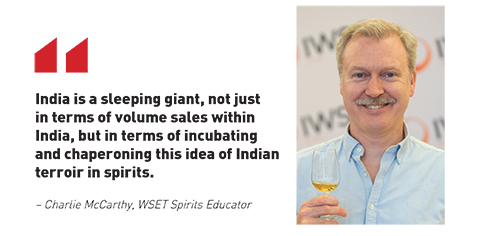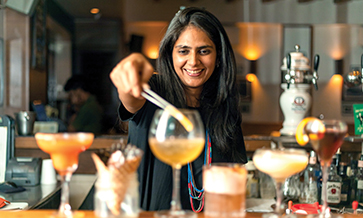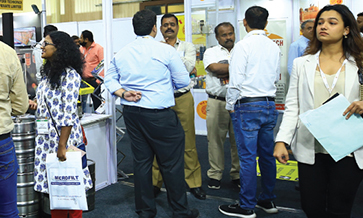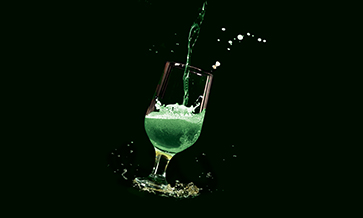The first in a series of panel discussions held during Brews&Spirits Expo, 2023. Excerpts:
Moderator
Vikram Damodaran, Chief Innovation Officer at Diageo India and Co-founder of Diageo India Craft Spirits
Panelists
Charlie McCarthy, WSET Spirits Educator
Pankaj Balachandran, Brand Director, Short Story
Ashok Chokalingam, Head Distiller & Head of International Sales, Amrut Distilleries
Michael John D’Souza, Master Distiller & Blender, John Distilleries
Vikram: We’ve been talking somewhat about the future of consumption. Who in your mind is the future consumer?
Pankaj: I think India’s grown in the last seven years to a completely different level. People are really well-traveled. I think it’s a great move forward because I can see that change happening in bars, restaurants, and also in liquor shops.
India has been a very heavy consumer of whiskey, brandy and rum. They all started off with a handful of brands and I think now we have over 20 brands in each category coming from India.
We have our superstar rums, but we have not really explored the rum’s category entirely, and I’m sure that there will be more of such categories to be built. So the future is, I think, building more and more categories.
Vikram: Ashok, you’ve been a pioneer in bringing Indian whiskeys to the world. What are the changes that you’re seeing with respect to younger consumers?
Ashok: The Indian consumer space has changed a lot over the years, and there are four reasons for it. Number one is exposure through international travel. You try to compare what you have imbibed and what is an alternate that is available in India. We already have about 25 different single malts in the market.
We are inching towards 280 million middle-class people, which is far ahead of the total population of the US. That’s another growth factor we are talking about. There is also a marked shift towards premium brands, where it’s quality over quantity. Last, but not least, communication is shaping all of us, from word of mouth to social media platforms to quick messaging services. All these factors together are driving the total synergy of different brands and offering them an amazing opportunity.
Vikram: Michael, where do you think consumers are going in terms of flavour appreciation across spirits?
Michael: Whiskey has been evolving, just as all other beverage alcohol categories. Today we know there is a moment and growth outside the traditional whiskey producers such as Scotland and Ireland. Today there’s a new generation of whiskey lovers.
To match this tremendous interest in unique and special experiments and diversified flavours, most distillers are using different managed methods and different ingredients to bring in new and exciting flavours.
Vikram: Charlie, what do you see India presenting great new experiences when it comes to alcoholic beverages?
Charlie: India is a sleeping giant, not just in terms of volume sales within India, but in terms of incubating and chaperoning this idea of Indian terroir in spirits. I think India has got such a range of unique culinary, gastronomic and agricultural expressions throughout the country.
Everybody around the world knows the culinary traditions of India. And I think there’s a really important moment coming up where everybody’s going to be exposed to how that is expressed in alcoholic beverages. It’s just a matter of pushing on an open door at the moment.
There is this concierge role that the brands, retailers and F&B practitioners have to take on to invite the consumer rather than forcing education and knowledge on the consumer.
Vikram: Jason, the IWSR is an amazing platform that helps us make the right decisions. But one of the things that we miss in IWSR is the small players. How do you marry the two?
Jason: One of the things that distinguish the number of companies I’ve worked for in the research space is the relationships that we have in the industry. But they’re not just with the big players. Obviously the big players are very important to give you some idea of the relative scheme of things. But the medium and small players, especially in a market such as India, are what excite me.
The smaller companies are the ones that are more likely to be the future of the market because they’re more nimble. But one must remember that the larger companies today used to be smaller.
We know that some smaller rum companies coming up. I found that one of the things that the Covid-19 lockdowns in India did was decelerate demand, but they accelerated experimentation. So, I’m very much going to go and see people that have started out and get those numbers in the pool as well.
Vikram: Pankaj, can you talk about the role of on-trade and retail in building your brand?
Pankaj: With Short Story, the idea was very simple: to get bartenders to be proud of what India can produce and use it in their cocktails and their regular serves. We saw that it had a massive impact on consumers going to these venues, and your liquid-to-lips is kind of taken care of immediately.
When consumers appreciate a product at an on-trade venue, they tend to pick it up from the retail. I think retail still plays 70% of your volume. The on-trade really plays a major role in early brand conversions.
Vikram: Ashok and Michael, you’ve been building credibility for your respective single malts. How does innovation play its role?
Ashok: The number of malt whiskey distilleries that have mushroomed around the world is confusing to any consumer. There are a thousand fine brands, ranging from US$20 a bottle to US$25,000 a bottle, which really makes it very difficult for the consumer to choose. We are different by bringing innovative concepts both in the distilling and maturation. The future for the Indian single malts category on the international market is equally entertaining and challenging.
Michael: Indians are known to be cost-conscious, not quality-conscious. But that is no longer the case. As long as you have quality products, I think you can establish a brand following anywhere.
Vikram: Charlie, since you spend time in education, what would you say about consumer advocacy and consumer education?
Charlie: Consumer advocacy is essentially the ultimate goal of any brand. I used to work for Hendricks gin, the single best brand in creating brand champions. They have a lot of bartender training and focus on the on-trade. But what they did right was to make the consumer the champion straight away.
The key to consumer advocacy is agency. The consumers have to feel that they have agency in how they share and express knowledge. I think the keys are premium experiences, brand coding and knowledge sharing. By the way, knowledge sharing between consumers is actually not very different from knowledge sharing among bartenders.
Certainly education has a big part to play. But it is the cross-pollination of information – amongst producers, retailers, distributors, amongst bartenders – that leads to innovation. They understand the link between the theory of how something is made and how that tastes in the glass, and that’s what gets them excited. I think that’s almost like the golden ticket that everyone’s looking for!
Vikram: If I were to give you each a magic wand now, what would you want to see happen?
Michael: It can be something that is exciting to our customers, a new sensory experience. You name any grain and we grow it here. So why not make something from different grains?
Charlie: I think from an innovation point of view, India has a unique opportunity around ambient yeast fermentation across all its categories. The unique biomes are available, and the unique wild fermentation opportunities are available across all categories. In India it is just mind-blowing!
Pankaj: I would just educate consumers on rums today as a category because India is only exposed to the Spanish style of rums. There is the Jamaican style of rums, English style and French style of rums.
For the full report, visit the Youtube channel of B&S Expo.














